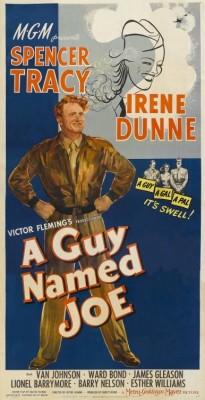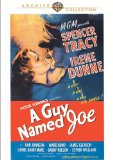| Reviews & Columns |
|
Reviews DVD TV on DVD Blu-ray 4K UHD International DVDs In Theaters Reviews by Studio Video Games Features Collector Series DVDs Easter Egg Database Interviews DVD Talk Radio Feature Articles Columns Anime Talk DVD Savant Horror DVDs The M.O.D. Squad Art House HD Talk Silent DVD
|
DVD Talk Forum |
|
|
| Resources |
|
DVD Price Search Customer Service #'s RCE Info Links |
|
Columns
|
|
|
Guy Named Joe, A
The movie, a peculiar jumble of fantasy-romance and wartime propaganda directed by Victor Fleming, stars Spencer Tracy, Irene Dunne, Van Johnson, and Ward Bond, with Esther Williams in a small part. The transfer is okay but quite possibly an old one. It's on the soft side and shows signs of wear and damage. A trailer is tossed in as an extra feature.
Produced and set during the Second World War, A Guy Named Joe casts Spencer Tracy as Pete Sandidge, a reckless B-25 bomber pilot based in England. He's in love with Women Airforce Service Pilot Dorinda Durston (Irene Dunne), but both she and Pete's superiors are continually frustrated by his stubborn unwillingness to be a team player, to play by the rules, and for continually showing off and taking unnecessary risks. His C.O., "Nails" Kilpatrick (James Gleason) transfers Pete and his best friend, Al Yackey (Ward Bond) to Scotland, later hoping Dorinda can convince Pete to agree to a transfer all the way back to the States, where his skills are needed as a flight instructor more than they are as a hotshot bomber pilot.
(Mild Spoilers) Before that can happen, however, about 30 minutes into the two-hour movie, Pete dies when his plane goes down off the coast after a suicidal bombing run against a German aircraft carrier.
In something like Heaven, Pete learns that in the afterlife, at least in 1943, U.S. Army Air Corps protocol and discipline extend into the clouds, where The General (Lionel Barrymore) assigns dead pilots to guardian angel-type duty, passing along their knowledge and experience to young fighter pilots. Accompanied by fellow war casualty Dick Rumney (Barry Nelson), Pete's unseen spirit takes an interest in Ted Randall (Van Johnson), an inexperienced but promising young pilot from a rich family.
Pete follows Ted all the way to the Pacific where luck finds him stationed at the same camp as Al and Dorinda, she still inconsolable one year after Pete's death.
A Guy Named Joe is a strange, not-quite-satisfying jumble of good and bad components. Tracy, as he almost always was, is excellent, particularly when he's allowed long, introspective monologues like one near the beginning when he talks about the spiritual appeal of flying to a group of curious British schoolchildren. (One of the children is played by 10-year-old Edward Hardwicke, son of Sir Cedric and later Dr. Watson on the Jeremy Brett Sherlock Holmes television series.)
Tracy and Dunne famously did not get along at first, she believing irascible Tracy wanted Katharine Hepburn to play her part. Reportedly, the tension between the two was so palpable some scenes had to be reshot. In the film, Tracy and Dunne are okay together but certainly lack the synergy of the Tracy-Hepburn pairings. More urgently, when 26-year-old Johnson begins romancing 44-year-old Dunne, their age difference and complete lack of chemistry is painfully obvious and it's like watching a high school boy romancing his middle-aged piano teacher.
Much more successful was the decision to keep Van Johnson on the film when, midway through production, Johnson's car was broadsided, the actor was ejected from the vehicle, and his head bashed against a curb. ("They lifted [my unstuck scalp] up and poured in handfuls of sulfa," Johnson later recalled.) Even after numerous plastic surgeries and a steel plate in his head, Johnson's appearance altered somewhat and long scars were visible on his forehead. Tracy and Dunne, their differences behind them, refused to let MGM replace their critically injured co-star and production was delayed nearly four months so he could adequately recover.
Viewers unaware of Johnson's condition might not even notice, partly because the movie was shot out of sequence (he's scarred in some scenes, not in others, randomly) and because subtle attempts are made to hide his scars; he usually wears a hat in his post-accident scenes. Despite the age difference with Dunne, Johnson delivers a good performance that was worth waiting for. Tracy and Dunne clearly inspire the rest of the cast, bringing out the best in actors like Ward Bond and Barry Nelson.
Also very good to excellent are the picture's miniatures. They are a little inconsistent, but many shots are almost imperceptible as special effects. Tracy's ghostly apparition, who cannot be felt or heard but whose presence is sensed subconsciously, is achieved with no special effects at all, but rather through simple, tasteful staging and Tracy's performance. Always to be taken with a grain of salt, a contributor to the Internet Movie Database makes the awesomely stupid claim worth quoting here: "There was no way to composite Spencer Tracy's image into the scenes where Van Johnson is flying, so he actually had to be standing behind Johnson and, later, Irene Dunne for the filming of these scenes. The same approach was used for The Ghost and Mrs. Muir (techniques for superimposing one image onto another were not invented until much later)." Not only is this totally inaccurate, the technique goes back to the mid-1890s (at least), the earliest days of cinema by pioneers such as Georges Méliès. What a maroon.
Ultimately, A Guy Named Joe's good parts don't result in a cohesive, satisfying whole. The propaganda angle is subtler than many middle-of-the-war offerings, but it still's overdone, with the song "Army Air Corps" ("Off we go into the wild blue yonder") not only repeated ad nauseum, but it competes with the far more appropriate "I'll Get By (As Long as I Have You)," which A Guy Named Joe helped popularize. The Army Air Corps-in-Heaven angle doesn't play well; where do the shot-down Luftwaffe pilots go? (The film offers no answer. None was necessary.) Powell and Pressburger pulled off something similar with far greater success in A Matter of Life and Death (1946). Unlike that film, which imagines a universal heaven for all religions and nationalities while acknowledging warring armies and the folly of war generally, A Guy Named Joe seems to suggest God is contributing to the Allied war effort Himself, dispatching angels to keep ‘em flying against the Axis menace.
And while Tracy is mesmerizing to watch, I never really bought his character. Possibly this view is colored from the later, straightforward, salt-of-the-earth parts Tracy mostly played after this, but an actor like Clark Gable or James Cagney would seem to have been more logically cast. Further, Fleming's direction and the male leads, notably Tracy and Bond, skew the romance into something from a man's perspective when maybe those parts of the film without Tracy would have played better if told from Dorinda's perspective.
Video & Audio
The full-frame, black and white A Guy Named Joe looks okay, though the video transfer is a bit soft and less detailed compared with what one might have expected, and there's a fair amount of damage, particularly around the 37-minute mark, when the right side of the frame is scratched all to hell for about 90 seconds. Otherwise, the Dolby Digital mono audio (English only, no subtitles) is acceptable on this region-free release.
Extra Features
The lone extra is an original trailer, which like the poster art (see above) doesn't even hint at the fantasy angle. Whether this was done for commercial purposes or an effort to surprise audiences not expecting it I cannot say.
Parting Thoughts
Worth seeing for the cast and scattered good moments, A Guy Named Joe is Recommended.
Stuart Galbraith IV is a Kyoto-based film historian whose work includes film history books, DVD and Blu-ray audio commentaries and special features. Visit Stuart's Cine Blogarama here.
|
| Popular Reviews |
| Sponsored Links |
|
|
| Sponsored Links |
|
|
| Release List | Reviews | Shop | Newsletter | Forum | DVD Giveaways | Blu-Ray | Advertise |
|
Copyright 2024 DVDTalk.com All Rights Reserved. Legal Info, Privacy Policy, Terms of Use,
Manage Preferences,
Your Privacy Choices | |||||||














